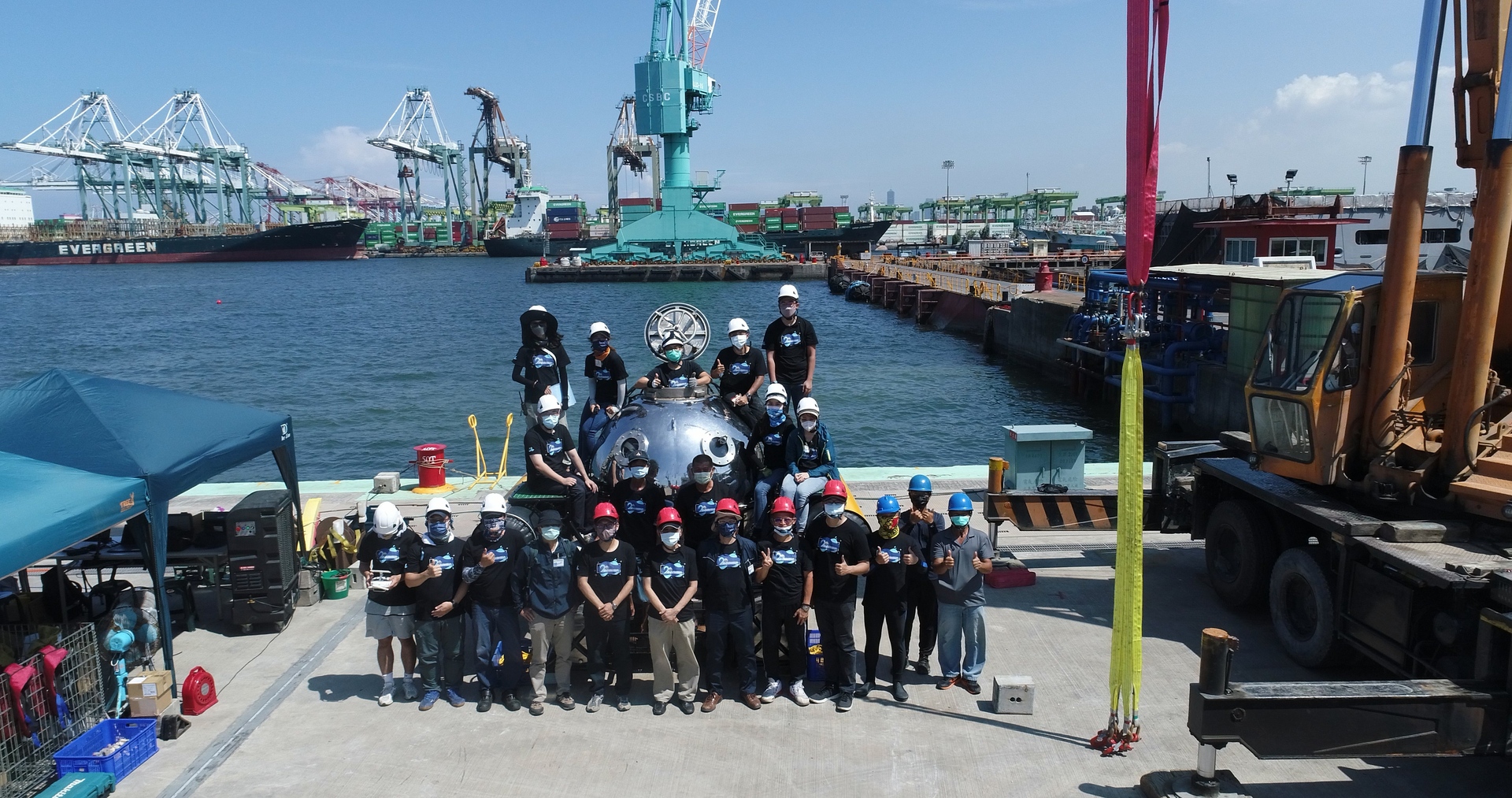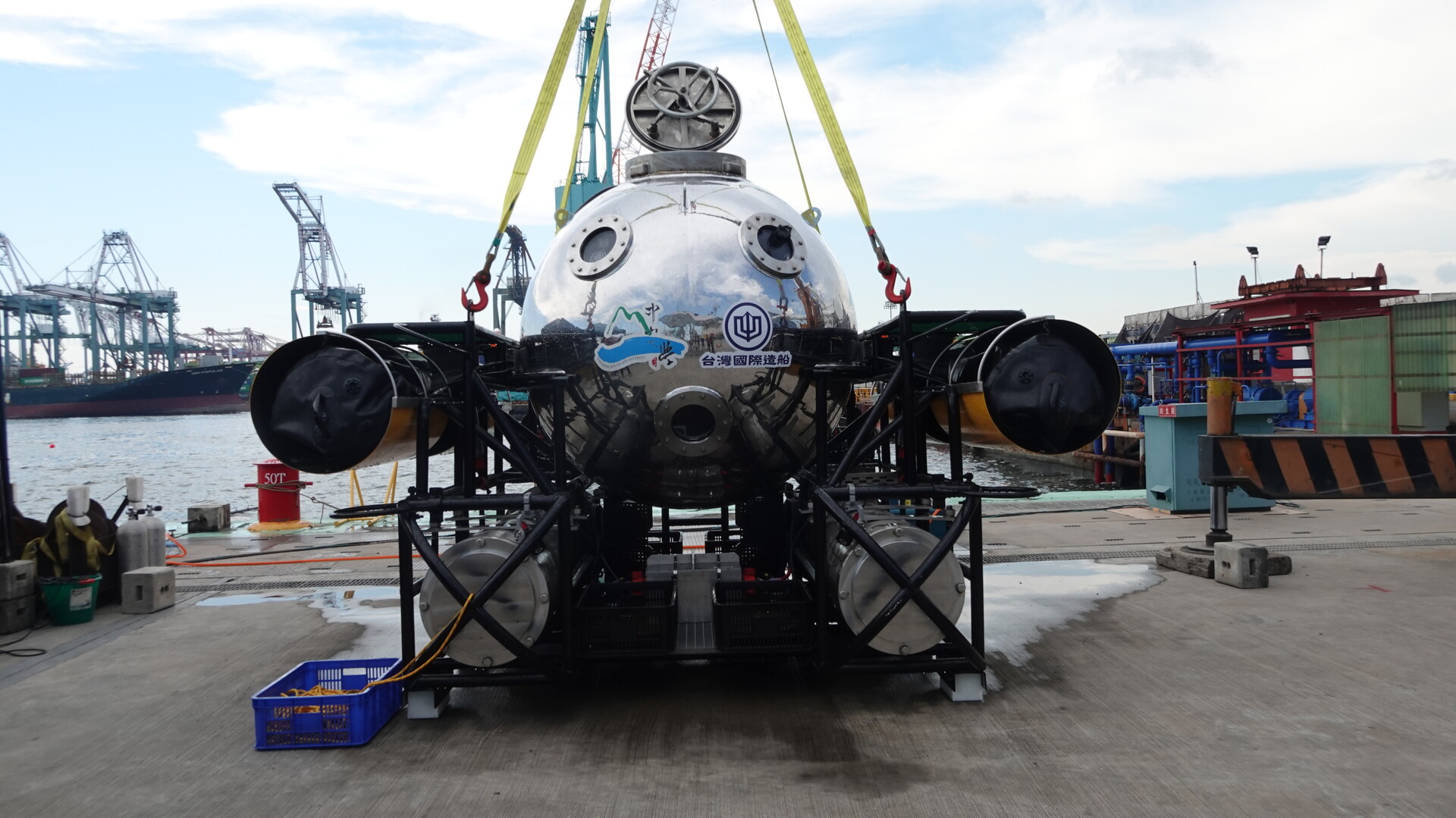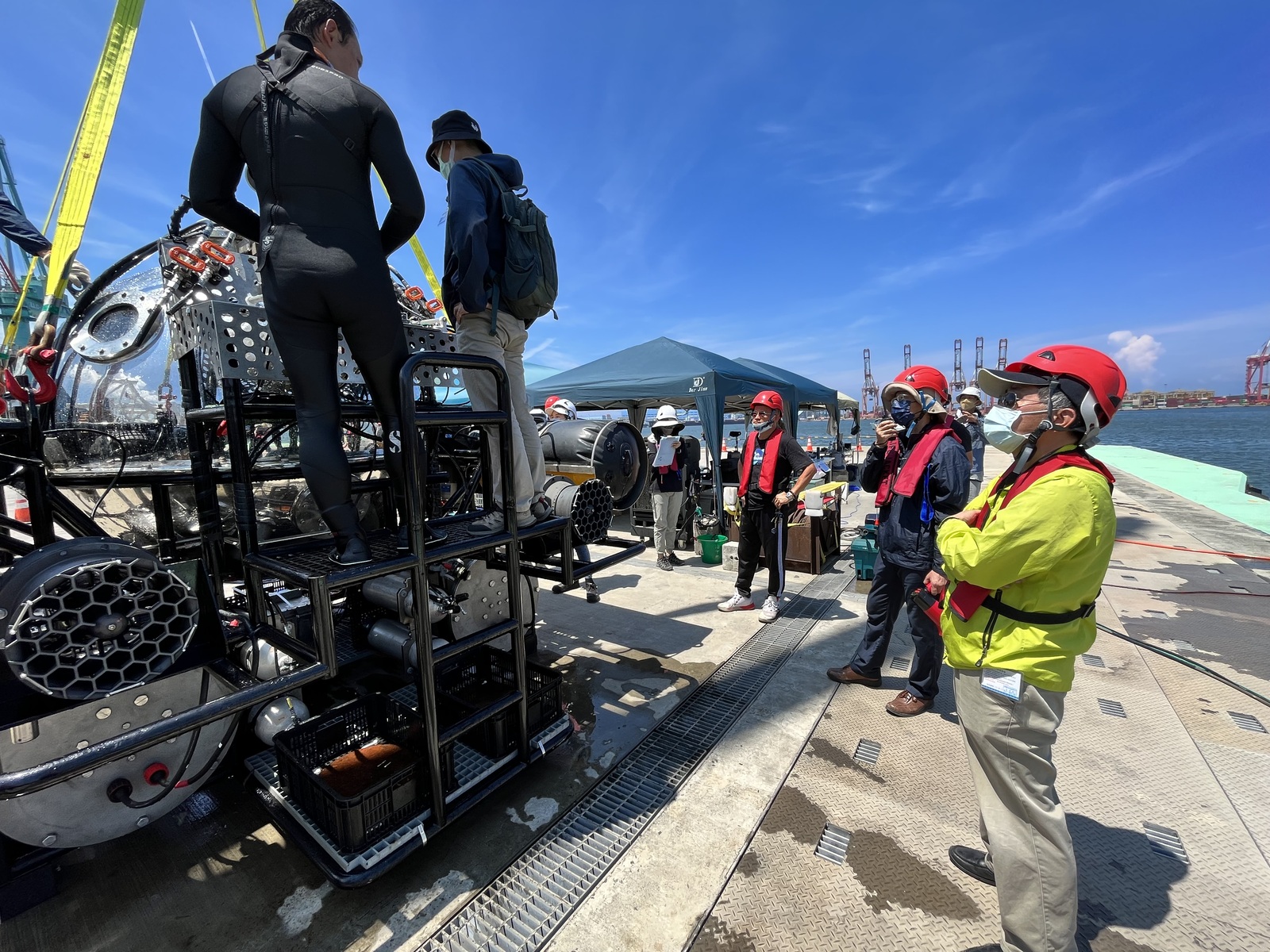NSYSU launched the test dive of newly developed two-seat submersible:A better onboard environment with air conditioning system



2022-09-26
Underwater Vehicle R&D Center, National Sun Yat-Sen University (briefed as UVRDC/NSYSU) had successfully developed the first made-in-Taiwan mini submersible and upgraded the spherical cabin to accommodate a researcher and a pilot with comfortable onboard environment. In addition to maintain proper oxygen and carbon dioxide levels, an underwater heat exchange air conditioning system is installed to keep the temperature and humidity at pleasant settings for the passengers. It is the first time that two operators got onboard to conduct the test dive in the calm waters of Kaohsiung Harbor. This success of the trial places an import milestone for the development of manned submersible technology in Taiwan.
This two-day test was jointly launched by UVRDC/NSYSU with CSBC Corporation. For the first day, the submersible was ballasted carefully with weights to get a balance attitude. The submersible descended with scuba divers filming and safe-guarding in a close range. The submersible maintained at 10 m beneath the water to test the functionality of the life support system. In 2021, the test was carried out without onboard air conditioning system. During the 40 minutes test, the logged temperature and humidity were 32 degrees Celsius and 90% respectively. “It feels like a long stay in sauna” says the operators. This year (2022), the center upgraded the life support system with an underwater air conditioning system so that the operators could stay cozy for more than one hour in the cabin, with the temperature being kept constant around 27 degrees Celsius and the humidity being decreased to 60%.
Chua-Chin Wang, Director of UVRDC, emphasized that the test has proved that the onboard life support system and environment conditioning system functions well as expected with endurance for hours underwater. For the sake of safety, the operators were queried to report the sensor readings via wireless and underwater walkie-talkies every five minutes. It is necessary to collect comprehensive data of the temperature, pressure, humidity, oxygen and carbon dioxide in the cabin, in consideration of improving the system. As humidity decreases, moisture cannot easily mist up the windows, making underwater visual surveys become promising and appealing.
Following up on the success of the life support system test and sea trials, the research team moved on to the stage to improve the operational environment within the cabin. Hsin-Hung Chen, director of the Institute of Undersea Technology (IUT) at NSYSU, explained the stages of the development process. The first priority was to develop the manual and automatic control systems of the submersible. The second priority to make sure that the oxygen/carbon dioxide circulation device functions normally in the cabin. The third priority was to develop an air conditioning system to adjust the temperature and humidity in the cabin to create a comfortable environment for the operators.
“One of the unexpected challenge of submersible operations for our team was the control of cabin temperature,” said Chau-Chang Wang, professor of IUT and Director of the Taiwan Ocean Research Institute (TORI/NARL). When researchers conduct underwater exploration at high-latitude waters, they put on sweater and jacket to keep themselves warm. For low-latitude waters around Taiwan, water temperature could be lower than 20 degrees Celsius at the depth of 500 m. However, the test was carried out at the depth of 20 m, and the water temperature can be as high as 20 to 30 degrees Celsius. With this condition, the cabin without air circulation, is a very sultry environment for the operators. Therefore, in addition to follow similar launch processes as that of the other international institutes, the team revised accordingly as: when the submersible stands by on the deck, cool air was pumped into the cabin as much as possible. The onboard air conditioning system is not turned on until the submersible is launched. The processes are designed with the concerns that the precious electric power should be preserved for the life support and propulsion of the submersible during the mission.
Recalled that not long ago, the life support system test in 2021 at the depth of 5 m underwater in Jong Shyn Shipbuilding Group’s port facility, moving on to designing the cabin for human operators. Afterwards, the first and the second sea trials were finished by October and November in 2021 at Liuqiu with a diver maneuvering the submersible outside of the cabin. The research team emphasized that the submersible, even with 4.2 tons gross weight, it is still minute when facing the mighty Mother Nature. The third sea trial is scheduled to be conducted by the end 2022. To survive challenges posed by the ever-changing ocean, NSYSU researchers will always keep a humble and cautious mind in exploring the unknown underwater world at all time.
Underwater Vehicle R&D Center, National Sun Yat-Sen University (briefed as UVRDC/NSYSU) had successfully developed the first made-in-Taiwan mini submersible and upgraded the spherical cabin to accommodate a researcher and a pilot with comfortable onboard environment. In addition to maintain proper oxygen and carbon dioxide levels, an underwater heat exchange air conditioning system is installed to keep the temperature and humidity at pleasant settings for the passengers. It is the first time that two operators got onboard to conduct the test dive in the calm waters of Kaohsiung Harbor. This success of the trial places an import milestone for the development of manned submersible technology in Taiwan.
This two-day test was jointly launched by UVRDC/NSYSU with CSBC Corporation. For the first day, the submersible was ballasted carefully with weights to get a balance attitude. The submersible descended with scuba divers filming and safe-guarding in a close range. The submersible maintained at 10 m beneath the water to test the functionality of the life support system. In 2021, the test was carried out without onboard air conditioning system. During the 40 minutes test, the logged temperature and humidity were 32 degrees Celsius and 90% respectively. “It feels like a long stay in sauna” says the operators. This year (2022), the center upgraded the life support system with an underwater air conditioning system so that the operators could stay cozy for more than one hour in the cabin, with the temperature being kept constant around 27 degrees Celsius and the humidity being decreased to 60%.
Chua-Chin Wang, Director of UVRDC, emphasized that the test has proved that the onboard life support system and environment conditioning system functions well as expected with endurance for hours underwater. For the sake of safety, the operators were queried to report the sensor readings via wireless and underwater walkie-talkies every five minutes. It is necessary to collect comprehensive data of the temperature, pressure, humidity, oxygen and carbon dioxide in the cabin, in consideration of improving the system. As humidity decreases, moisture cannot easily mist up the windows, making underwater visual surveys become promising and appealing.
Following up on the success of the life support system test and sea trials, the research team moved on to the stage to improve the operational environment within the cabin. Hsin-Hung Chen, director of the Institute of Undersea Technology (IUT) at NSYSU, explained the stages of the development process. The first priority was to develop the manual and automatic control systems of the submersible. The second priority to make sure that the oxygen/carbon dioxide circulation device functions normally in the cabin. The third priority was to develop an air conditioning system to adjust the temperature and humidity in the cabin to create a comfortable environment for the operators.
“One of the unexpected challenge of submersible operations for our team was the control of cabin temperature,” said Chau-Chang Wang, professor of IUT and Director of the Taiwan Ocean Research Institute (TORI/NARL). When researchers conduct underwater exploration at high-latitude waters, they put on sweater and jacket to keep themselves warm. For low-latitude waters around Taiwan, water temperature could be lower than 20 degrees Celsius at the depth of 500 m. However, the test was carried out at the depth of 20 m, and the water temperature can be as high as 20 to 30 degrees Celsius. With this condition, the cabin without air circulation, is a very sultry environment for the operators. Therefore, in addition to follow similar launch processes as that of the other international institutes, the team revised accordingly as: when the submersible stands by on the deck, cool air was pumped into the cabin as much as possible. The onboard air conditioning system is not turned on until the submersible is launched. The processes are designed with the concerns that the precious electric power should be preserved for the life support and propulsion of the submersible during the mission.
Recalled that not long ago, the life support system test in 2021 at the depth of 5 m underwater in Jong Shyn Shipbuilding Group’s port facility, moving on to designing the cabin for human operators. Afterwards, the first and the second sea trials were finished by October and November in 2021 at Liuqiu with a diver maneuvering the submersible outside of the cabin. The research team emphasized that the submersible, even with 4.2 tons gross weight, it is still minute when facing the mighty Mother Nature. The third sea trial is scheduled to be conducted by the end 2022. To survive challenges posed by the ever-changing ocean, NSYSU researchers will always keep a humble and cautious mind in exploring the unknown underwater world at all time.
Click Num:
Share
